Tawny Crazy Ants Summary
- Cannot be controlled by spraying alone.
- Become a nuisance to people by rapidly crawling on them and spoiling the enjoyment of their property and recreational areas (Figure 1).
- Do not sting but can nip with chewing mouthparts.
- Are known to cause electrical shortages and may damage expensive equipment.
- Decrease ecosystem diversity by displacing other species (LeBrun et al. 2013).
- Have been observed to cause considerable damage in organically grown crops in some Caribbean islands, although there are no reports of agricultural damage in Florida. In Columbia, Zenner-Polanía (1990) reported infestations in coffee plantations intercropped with banana and plantain trees used as shade.
- In Columbia, Zenner-Polanía (1990) also reported that the large number of ants caused death in small animals due to asphyxia. Larger animals also were attacked "around eyes, nasal fossae and hoofs."
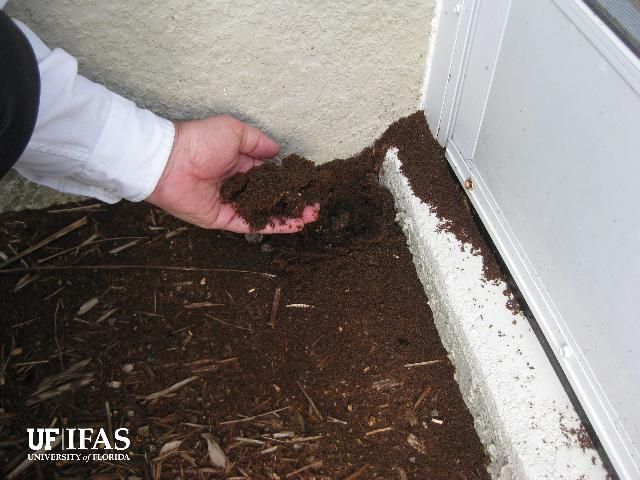
Credit: UF/IFAS
Distribution
The tawny crazy ant:
- Has predictably spread throughout the state of Florida over the last few years and now can be found in some parts of at least 26 counties as well as other southern states (Figure 2).
- Are an invasive species with probable origins in South America.
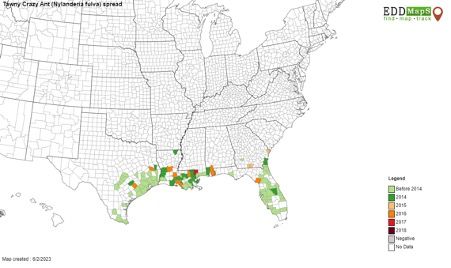
Credit: Used with permission, J. MacGown, Mississippi Entomological Museum (https://www.eddmaps.org/tca/distribution.cfm)
Identification
Tawny crazy ants are named for their reddish-brown color and their manner of locomotion (they zip around quickly and erratically). Workers are medium-sized (<1/8 inch in length) and monomorphic (one body size) (Figure 3). They are most notorious for their massive, sprawling colonies, consisting of millions of individual ants. Homeowners have reported that "the ground is moving" in areas of heavy infestation. Tawny crazy ants do not form mounds in the landscape, although they can tunnel in sandy soil (Bentley et al. 2015), contrary to previous reports. Colonies most often nest in moist spaces in or under leaf litter, stones, branches, trash, potted plants, or any other similarly suitable material/debris. Colonies are polygynous (multiple queens) (Eyer et al. 2018) and many queens (Figure 4) can sometimes be found among the workers, especially during spring and summer.
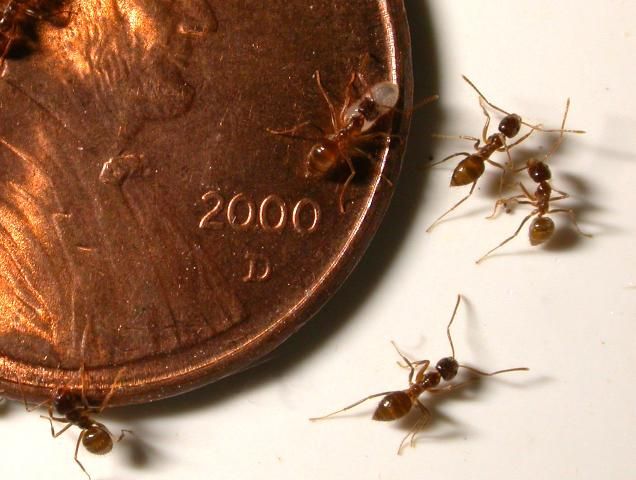
Credit: USDA ARS CMAVE
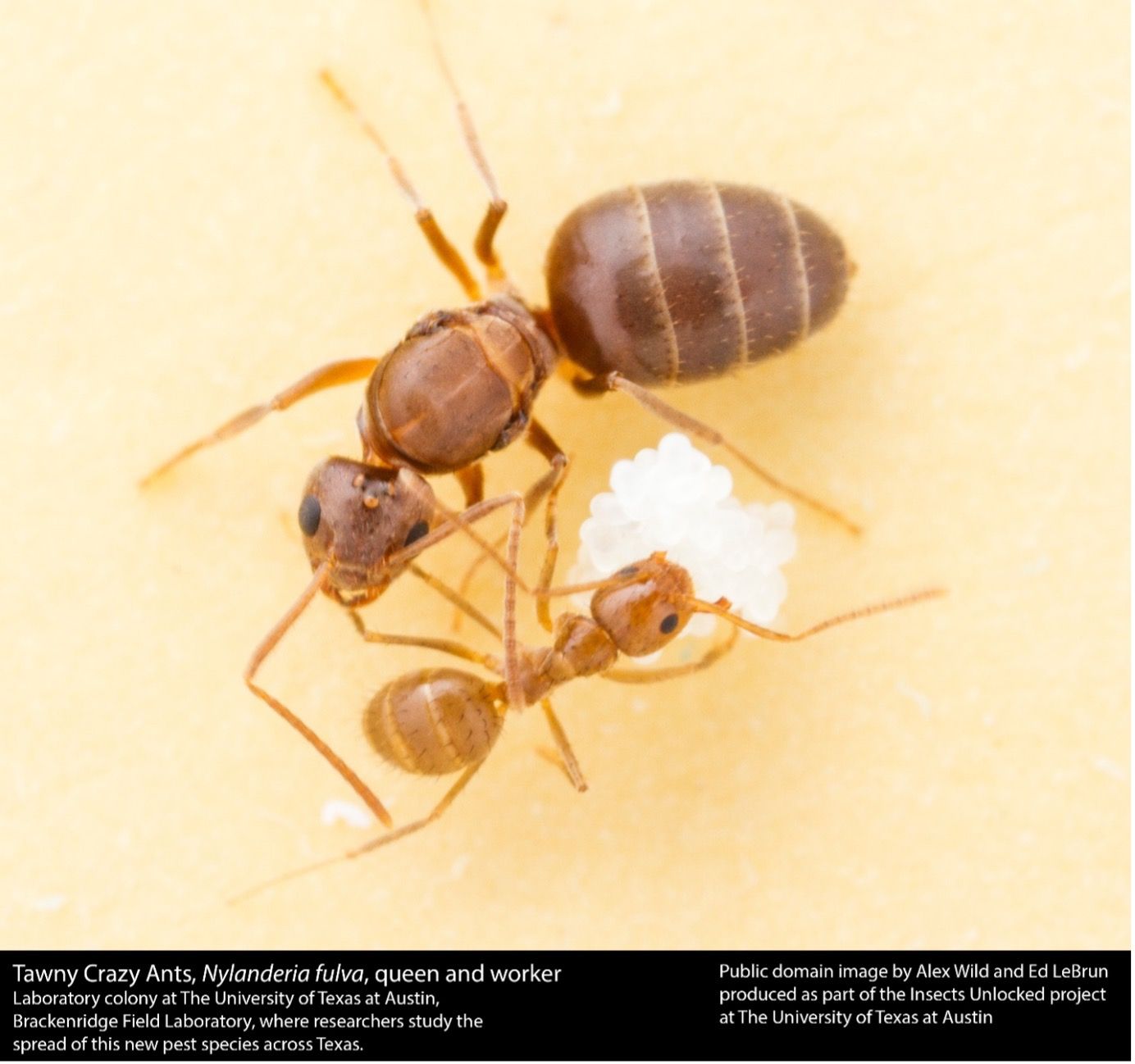
Credit: Alex Wild and Ed LeBrun
Tawny crazy ants have one triangular petiole (‘waist’) segment and twelve antennal segments, including the scape (long first segment) (Figure 5). Under a microscope, many long, dark standing hairs (macrosetae) and a fine layer of downy hair (pubescence) can be seen on most parts of the body, giving the surface a somewhat matte appearance. These ants do not have a sting at the tip of their abdomen, and instead have a small, circular pore (acidopore) surrounded by a ringlet of tiny hairs.

Credit: AntWeb.org, image taken by April Nobile
If identification assistance is needed please contact your local UF/IFAS Extension office (https://sfyl.ifas.ufl.edu/find-your-local-office/) or our Insect ID laboratory (https://entnemdept.ufl.edu/insectid/).
General Management Facts
- Relying on a single control tactic for this ant will result in failure. Our data indicate that a single insecticide spray lasts <1 week with an average of 2 to 3 days before ants begin to return.
- Our data indicate that commonly used products may result in low or slow mortality (Figure 6).
- An integrated pest management (IPM) approach provides more satisfactory results, but does not promise 100% control due to the invasive nature of this ant.
- IPM is a dynamic process that uses multiple control tactics. It starts with correct pest identification and monitoring.
- An IPM Decision Flow Chart and Specific Approaches for this pest ant are provided in the flow chart below (Figure 7).
- The timing of product applications is as important as the product chosen.
- Management of this ant will most likely require the services of a professional pest control company that practices IPM.
- Ant activity will subside when the weather starts to cool but, expect the ants to reinvade next year. The predictable pattern of reinvasion is why it is important to keep records of where this ant was found on a property.
- 100% eradication of this ant is not probable in areas where it is established; however, population suppression is possible.
- Perhaps due to disease and other factors (LeBrun et al. 2022), within about 10 years after establishment, tawny crazy ant populations subside and other ant species return.
- There is a legal limit as to how often products can be used, so please do not ask your pest control operator to do "extra" treatments.
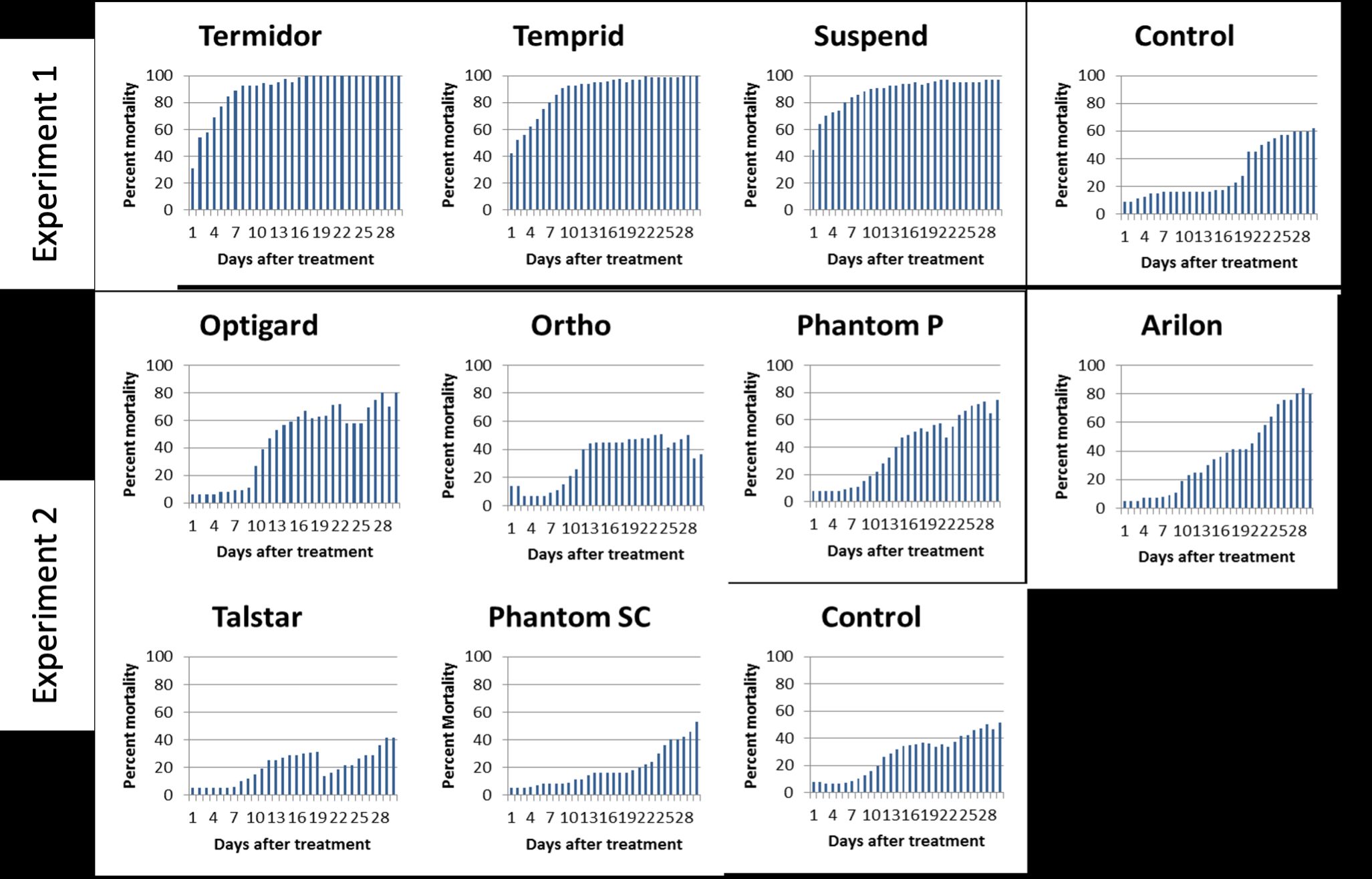
Credit: Calibeo et al. (2017)
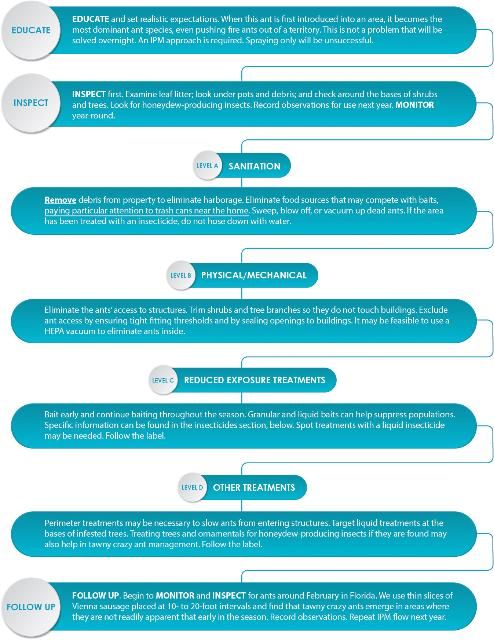
Credit:
Integrated Pest Management
If you live in an area with tawny crazy ant activity, sanitation in combination with inspection and monitoring will be ongoing and important in suppressing ant activity. Start monitoring around February. Thin slices of canned sausage placed 10 to 20 feet apart are effective in monitoring by drawing out ants that may not be readily visible (Figure 8).
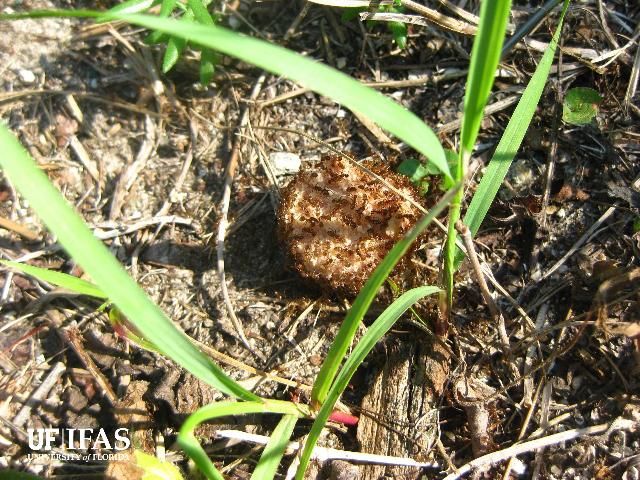
Credit: UF/IFAS
After determining the presence of the tawny crazy ant and depending on the severity of the infestation, a possible treatment protocol may include placing granular and liquid baits on the perimeter of the property, treating the lawn with a granular contact insecticide, treating trees and shrubs with a systemic insecticide to manage honeydew-producing insects, and administering a spot or perimeter treatment of the structure. Always follow the label. Applications can be done simultaneously with sanitation and exclusion tactics.
Sanitation
"Harborage" is a place where insects live and breed. The most important thing a homeowner can do is to eliminate as much harborage as possible, including leaf litter and branches. Homeowners should not just pile these up, but should get them off the property. Zenner-Polanía (1990) has anecdotal evidence from coffee plantations that the number of nests decreased by 23% just by removing plant debris from the property. Removing debris also will increase the effectiveness of product applications because there will be fewer "pesticide-free" zones.
Outdoors
- Schedule regular trash pick-up. Keep trash cans clean and stored away from the home.
- Remove leaf litter, fallen branches, and other yard debris.
- Keep hedges and trees trimmed so that they do not touch the home.
Indoors
- Eliminate or reduce possible food, water, and nesting sources.
- Remove trash regularly and keep trash receptacles clean.
- Do not leave dirty dishes in the sink.
- Clean up spills immediately.
- Place food items in the refrigerator or in sealed containers.
- Pick up pet food bowls when your pet is not eating.
Exclusion
To prevent ants from entering a home, walk around the outside of the home and locate potential entry points (cracks, crevices, spaces around windows and doors) (Figure 9). Locate indoor entry points, paying particular attention to windows, doors, and plumbing and utility penetrations. Use an appropriate sealant. Replace door thresholds and weather stripping as needed. If you can see light from the outside while you are standing inside, it is enough of a gap for ants and other pests to enter.
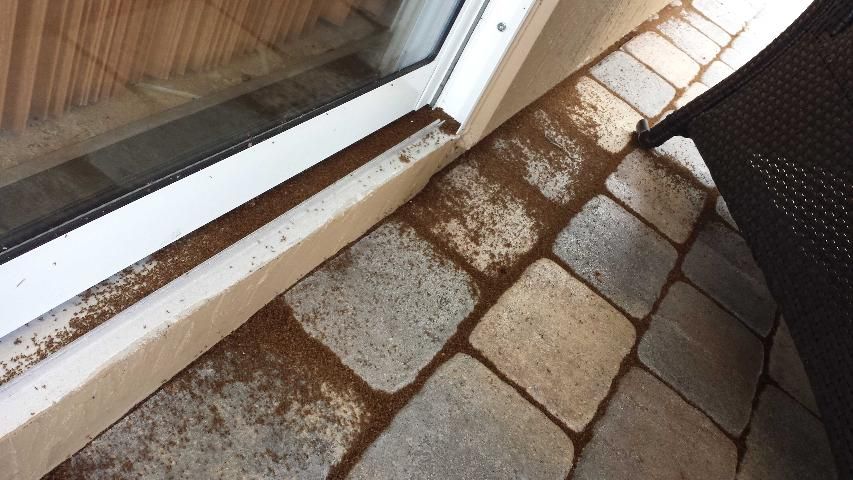
Credit: R. Bernal
Insecticides
Always follow the use directions on the label. The label is federal and state law. Control of this species requires the use of all aspects of IPM. It is not unusual that multiple insecticide products are used in addition to sanitation and exclusion. Since some products do not work together, consult a pest-management professional who can implement an effective IPM program.
Baits
Think of baits as a first line of defense. Examples of baits can be found in Table 2. Insecticidal baits can be very effective in suppressing large ant colonies because baits exploit food sharing behavior (trophallaxis) in ants. Granular insecticidal baits should not be confused with granular contact insecticides. Granular baits require ingestion; granular contact insecticides simply require contact with the product. Insecticidal baits can be formulated as granular, liquid, or containerized products.
- Before applying bait to large areas, it is important to make sure that the ants are feeding on the bait by placing a small amount of bait where ants are present and simply observing whether the ants will feed on it.
- Baits scattered directly on to the ground, according to product label instructions, can make bait granules easily accessible to ants over large areas.
- Alternatively, granular bait can be dispensed within ant bait stations or other secured box. Bait stations can extend the longevity of the bait by protecting it from Florida's harsh environment or landscape irrigation (Figure 10).
- Station placement is important. Consider elevating stations in low-lying areas to avoid flooding, or simply place stations where they will not be subject to flooding.
- Some baits will mold and become unpalatable in protected stations. Our research demonstrated that placing 2 to 4 oz. of MaxForce® Complete* (Envu) granular bait in rodent boxes (Figure 10) extended the palatability of the bait to at least a month during the summer. (*Not an endorsement.)
- During the hot summer months, many ants prefer liquid baits.
- Our research demonstrated it is possible to achieve a ~50% reduction in ants by applying baits when ants are actively foraging, starting with a MaxForce® Complete, then by adding MaxForce® Quantum-dilute liquid bait in additional locations in June. Other granular and liquid bait combinations also may be effective.
- During the winter, tawny crazy ant queens and workers have been observed to congregate within nests often located at the base of trees, or other protective harborages. In these winter nests, very little brood (eggs, larvae, and pupae) was present (Oi 2020), which may indicate colonies are not actively feeding. This suggests that instead of applying baits in the winter to target queens consolidated within nests, applying baits in the spring when egg laying starts and colonies are actively foraging, could be more effective (Oi 2021).
- Expect to see ants after the application of any bait because it will take at least a few hours to days for the toxicant to spread.
- Do not disturb the foraging ants because they will stop picking up the bait and sharing it.
- Do not use other insecticides or strong household cleaners in the areas where the baits have been placed because this will contaminate the bait and make it unpalatable to the ants.
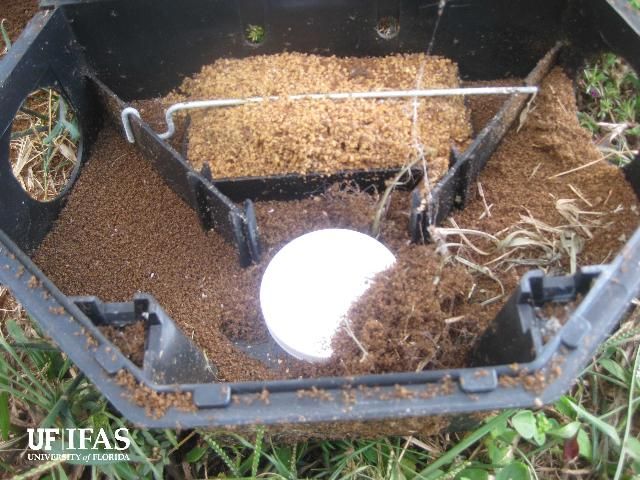
Credit: UF/IFAS
Generally, baits are formulated for protein-feeders, sweet-feeders, and oil-feeders. Baits for oil-feeders are predominantly directed toward fire ant control and are not represented below. Bait particles also need to be an appropriate size for the ants to pick up. Table 2 provides examples of each of these kinds of baits.
Baits for indoor use can be in the form of a plastic bait station that is placed on surfaces where ants are found, or as a gel or paste that is applied to cracks and crevices using a syringe-like device. Insecticidal baits are effective against some species of ants, but at this time, we do not know of any over-the-counter products that are consistently effective against the tawny crazy ant. Always follow the instructions on the label when using any form of insecticide.
Contact Liquid and Contact Granular Insecticides
As mentioned under “Baits,” during the winter, tawny crazy ant queens and workers have been observed to congregate within nests often located at the base of trees, or other protective harborages. Fall and winter may be a good time to apply contact insecticides if ants are observed around the base of trees and other protective harborages.
Insecticides are often erroneously categorized as "repellent" or "non-repellent." Truly repellent insecticides will deter ants from entering the home; however, these products actually cause ants to die quickly upon contact. Quick kill provides very little opportunity to transfer the toxicant to other ants. These products are often used around windows, doors and other openings.
Look for products that contain active ingredients in the pyrethroid class of chemistry: permethrin, allethrin, cyhalothrin, etc. There are many insecticides with these active ingredients that can be purchased by homeowners and pest management professional for temporary relief.
A pest management professional may also apply slower acting, so-called "non-repellent" insecticide sprays to areas where ants are active. These insecticides are generally slower acting and have the advantage of being transferred easily from ant to ant. This allows more ants in the colony to be exposed to the insecticide. Because non-repellent insecticides will not deter ants from entering openings around windows and doors, homeowners and pest management professionals should be aware that more ants may die inside the home. Examples of professional products are listed in Table 3.
- Do not apply liquid and granular products in areas where baits are applied. They will contaminate the bait, rendering it ineffective.
- Pay careful attention to the bases of trees and shrubs. Zenner-Polanía (1990) found 80% (64 of 80) tawny crazy ant nests around the bases of trees.
- A tremendous number of ants will die after a perimeter treatment with a contact insecticide, often covering the treated area. Use a blower or broom to remove the dead ants. Do not hose down the area with water, which will wash away the treatment.
Frequently Asked Questions about Tawny Crazy Ants and Their Control
- What might I see a pest control professional do?
- Treat landscape plants for honeydew producing insects that tawny crazy ants tend.
- Spread insecticidal granules that kill ants by contact.
- Spray liquid insecticides around the perimeter of your house.
- Apply baits that ants will consume and share with other ants.
- Apply crack and crevice insecticidal products on the inside of homes or buildings.
2. What can't my pest control professional do?
- Treat other people's property.
- Put pesticides down sewers.
- Make "off-label" (i.e., illegal) applications.
3. What should homeowners do and expect?
- Make sure you have a correct identification for this ant.
- Be a good neighbor and eliminate food, water, and shelter that encourages colony growth.
- De-clutter and remove debris and unneeded items from the property.
- Establish regular trash removal.
- If you have taken pest control measures, please do not hose the ants off the pavement area. You will wash away your treatment. Use a blower instead.
- Prepare to pay for monthly (or more frequent) pest control service.
- Be cautious about "self-treating," especially if you have hired a professional because your efforts may counteract what your pest control professional has already done. For example, if you spray an insecticide over a bait, you will render the bait ineffective.
4. How cold does it have to get before I can expect some relief from this ant?
Observations from our field work indicate that when temperatures reach about 50°F, activity significantly slows. In the laboratory, Bentley et al. (2016) found that the critical thermal minimum—the temperature at which the ant stops moving—is about 45°F. If you are curious about how hot it has to be, the thermal maximum (when ants started twitching) was ~106°F.
5. Why is this ant so invasive?
Good question. Part of the answer lies in the tremendous number of queens associated with colonies—another reason that spraying only is generally ineffective and baiting is more effective. This ant is simply a better competitor for resources when it moves into a territory. We will have more to report on in the future.
6. Is it true that this ant can detoxify fire ant venom?
Yes, which is another reason this ant is so dominant. (LeBrun et al. 2014 contains details.)
7. Is this the same ant as the Caribbean crazy ant, Rasberry crazy ant, brown, or hairy crazy ant?
Most would say yes. In order to conclude that ants with these different common names are Nylanderia fulva, Gotzek et al (2012) used morphometric and molecular data of ants collected from Florida, Mississippi, Texas, Paraguay, St. Kitts, US Virgin Islands, Anguilla, Barbados, St. Lucia, St. Vincent, and Rio de Janeiro, Brazil. Zhao et al. (2012) used molecular comparisons to conclude that the samples of ants from Texas and Florida were the same, but they did not assign the ants to the species Nylanderia fulva. We do have records of closely related N. pubens in Florida.
If You Are a Pest Management Professional
We have developed door hangers that contain a space for your company logo at the front. You may download for printing at:
Commercial printing: http://schoolipm.ifas.ufl.edu/crazy_ant_door_hanger_COMMERCIAL%20PRINTER.pdf
Printing on your own laser printer: http://schoolipm.ifas.ufl.edu/crazy_ant_door_hanger_PRINTABLE.pdf
Acknowledgements
This work was supported by the USDA National Institute of Food and Agriculture (NIFA), Hatch project FLA-ENY-005787 and USDA NIFA Crop Protection and Pest Management Grant 2018-70006-28919.
Selected References
Bentley, M. T., F. M. Oi, S. A. Gezan, and D.A. Hahn. 2015. Tunneling performance increases at lower temperatures for Solenopsis invicta (Buren) but not for Nylanderia fulva (Mayr). Insects 6:686–695. doi:10.3390/insects6030686.
Bentley, M. T., D.A. Hahn, and F. M. Oi. 2016. The thermal breadth of Nylanderia fulva (Hymenoptera: Formicidae) is narrower than that of Solenopsis invicta at three thermal ramping rates: 1.0, 0.12, and 0.06°C min-1. Environ. Entomol. DOI: https://doi.org/10.1093/ee/nvw050 First published online: 1 June 2016.
Calibeo, D., F. Oi, D. Oi, and C. Mannion. 2017. Insecticides for suppression of Nylanderia fulva. Insects 8(3), 93; https://doi.org/10.3390/insects8030093.
Eyer, P.-A., McDowell, B., Johnson, L. N. L., Calcaterra, L. A., Fernandez, M. B., Shoemaker, D., Puckett, R. T., & Vargo, E. L. (2018). Supercolonial structure of invasive populations of the tawny crazy ant Nylanderia fulva in the US. BMC Evolutionary Biology, 18, 209. https://doi.org/10.1186/s12862-018-1336-5.
Gotzek, D., S. G. Brady, R. J. Kallal, and J. S. LaPolla. 2012. The importance of using multiple approaches for identifying emerging invasive species: The case of the Rasberry crazy ant in the United States. PLoS ONE 7(9): e45314. doi:10.1371/journal.pone.0045314.
LeBrun, E. G., J. Abbott, and L. E. Gilbert. 2013. Imported crazy ant displaces imported fire ant, reduces and homogenizes grassland ant and arthropod assemblages." Biological Invasions 15: 2429–2442.
LeBrun, E. G., N. T. Jones, and L. E. Gilbert. 2014. Chemical warfare among invaders: A detoxification interaction facilitates and ant invasion. Science 343 (6174): 1014–1017. DOI: 10.1126/science.1245833.
LeBrun, E. G., M. Jones, R. M. Plowes, and L. E. Gilbert. 2022. Pathogen-mediated natural and manipulated population collapse in an invasive social insect. Proceedings of the National Academy of Sciences of the United States of America 119(14)e2114558119. DOI: 10.1073/pnas.2114558119.
Oi, D. 2020. Seasonal prevalence of queens and males in colonies of tawny crazy ants (Hymenoptera: Formicidae) in Florida. Florida Entomologist 103: 415-417.
Oi, D. 2021. The seasonal reproductive status of tawny crazy ant queens (Hymenoptera: Formicidae) in Florida. Florida Entomologist 104: 140-142.
Sharma, S., J. Warner, and R. H. Scheffrahn. 2014. Tawny Crazy Ant (previously known as Caribbean crazy ant) Nylanderia (formerly Paratrechina) fulva (Mayr) (Insecta: Hymenoptera: Formicidae: Formicinae). EENY-610. Gainesville: University of Florida Institute of Food and Agricultural Sciences. https://edis.ifas.ufl.edu/in1071
Sharma, S., E. A. Buss, G. S. Hodges, and D. H. Oi. 2019. Effect of soil treatments for cottony cushion scale (Hemiptera: Monophlebidae) control on Nylanderia fulva (Hymenoptera: Formidicae) survival and trailing activity. Florida Entomologist 102: 202-206.
Zenner-Polanía, I. 1990. Biological Aspects of the 'Hormiga Loca' Paratrechina (Nylanderia) fulva (Mayr), in Colombia. pp. 290–297. In: R.K. Vander Meer, K. Jaffe & A. Cedeno [Eds.]. Applied Myrmecology. A World Perspective. Westview Press, Boulder, CO.
Zhao, L., J. Chen, W. A. Jones, D. H. Oi, and B. M. Drees. 2012. Molecular comparisons suggest Caribbean crazy ant from Florida and Rasberry crazy ant from Texas (Hymentoptera: Formicidae: Nylanderia) are the same species. Environ. Entomol. Volume 41, Issue 4, Pages 1008–1018, DOI: https://doi.org/10.1603/EN11287 First published online: 1 August 2012.
Examples of professional product baits based on feeding preference.